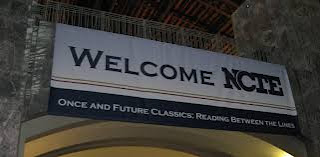"Those things you learn without joy, you will forget easily." -- Finnish proverb
When I first started attending NCTE, I stalked the footnotes. I made sure I was up early to claim a front row seat
to listen to Nancie Atwell, hoping she’d help me figure out that one part of my
workshop that was still rough. I pushed through the crowds to listen to Donald
Murray, yearning for that one nugget that would move those reluctant writers. I
searched for the specific activity, the practical idea, the thing to do on
December 1. I was in search of the tip and trick, the cool activity that would hook my kids.
Times have changed. Now I’m not stalking the footnotes in search of the practical; I’m no longer pushing through crowds to get that
last handout. Yes, I still get up early
to listen to the keynoters and make my way through the crowds to listen to Tom
Newkirk or Jeff Wilhelm or Vicki Vinton. But the aura surrounding the famous
has faded, and I don’t gasp when I see Lucy Calkins. Now I’m stalking for a
different purpose: someone who will provoke me, nudge my thinking, make me
think in new ways. Now I want to stalk the idea. It’s the idea that lures me
back each year to NCTE, ideas swirling around the heads of those most prominent
in our field, ideas that are about to – or should be about to – catch on fire,
ideas that like the wind force the skyscape of my mind to be a bit brighter,
look a little different.
And what were the ideas that most grabbed me this year?
Bring on the joy and
the pleasure
No, no one said it exactly like this, but joy was in the air. When Ellin Keene talked about engagement, she was talking about joy. Engagement,
Ellin argued, is “born of emotional
response to ideas.” Isn’t that joyfulness? When Jeff Wilhelm challenged us to
reflect on whether or not “we would do the crap that we assign students,” he
urged us to think about the role of pleasure. Why wouldn’t we think about
pleasure as we nurture our readers, our students? Why wouldn’t we remember that
pleasure exists in the world of play, work, the intellect, and the social? And
when Penny Kittle advocated for students selecting their own books 75% of the time,
she too was talking about joy and pleasure. What if, she asked, students didn’t
fake read? What if it were otherwise? After all, if our kids don’t love
reading, they’re not going to do it when we leave the room.
Oh, yeah, bring on that joy! Invite pleasure into the classroom!
Eliminate the great
divide
Tom Newkirk warned us that we are plagued by a category
problem. Yep, it’s CCSS’s three categories of writing: narrative, information, and argument. Good
writing, he reminded us, crosses that great divide and blurs the lines between
categories. All writing that we want to read is told by a narrator that we want
to follow and that kind of writing leads us through surprise after surprise. Yes, the writing might
convey information, but it’s the story that carries the day.
Linda Hoyt and Seymour Simon disabused us of the notion that
good nonfiction writing is devoid of voice and style. Instead beautifully
crafted sentences belong to the both the worlds of fiction and nonfiction. The
beauty and power of a well-crafted sentence ushers us into the factual world of
the gorillas and nudges us into the fiction of Joseph Conrad.
And, by the way, how is it that we have the categories of
fiction and non-fiction? Doesn’t fiction contain truth, and doesn’t non-fiction
carry us away through the story? Perhaps
that’s another divide that we need to close.
Get curious
Sessions on inquiry filled the conference docket, and Steph Harvey, Smokey
Daniels, and Sara
Ahmed did a great job getting us curious. Steph Harvey reminded us of Sir Ken Robinson's statement: Curiosity is the engine that
drives achievement. Inquiry doesn't just lead to a cool project at the end of a unit; instead, it's how we should live our lives. To illustrate the importance of teachers living a curious life, Sara Ahmed showed us images of Syrian ruins in the desert and of beautiful Syrian children, images not often seen in popular media. Smokey nudged us to develop an inquiry question that emerged from studying those provocative images. For about 10 minutes 100 educators or more engaged in inquiry, and when Smokey and Sara tried to call us back, a good share of us tried to ignore them so that we could continue exploring. Inquiry is addicting.
Carol Jago's message at CEL dovetailed Smokey's and Sara's work with visual images and inquiry. After showing us a few images from Gordon Park's A Harlem Argument, she invited us to talk about how those stunning images build a visual argument. Our job was to figure out that argument and determine who the argument was for. After showing us beautiful and provocative paintings by Kehinde Wiley, she juxtaposed Claude McKay’s “If We Must Die” and invited us to write. Those images promoted curiosity and heightened our response to the literature she had paired with them.
Even though I was ready to head home after the conference -- already I had been away for over a week and a half, I left refreshed and so glad that I had stalked the idea makers. The skyscape of my mind had altered. Already I’m planning for next year, curious about what joy
will look like in 2016 and what ideas will dominate.


Isn't it nice to reflect on how you've moved from first looking for a quick tip or trick to use in the classroom to now focusing on the very essence of learning?!
ReplyDelete